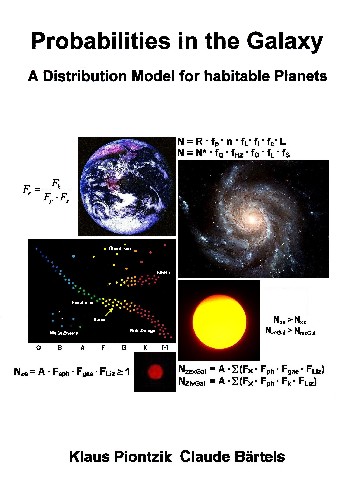 |
Today's
civilization has been at the 6th level for about
300 years, and we are standing with the moon
landing in 1969, and the construction of the
international space station ISS since 1998, at
the beginning of the seventh stage.
Only two of the eight stages of development
therefore represent comparable technological
civilizations, namely levels 6 and 7. This
corresponds to a probability of: |
Fz
= 14,400:7,301 · (1:36+1:49) = 34,000:357,749 = 1:10.522
FLiz = FL · Fi · Fz
= 1:9 · 1:14 · 34,000:357,749 = 1:1326
comparable technological civilizations
Inserting all values (Fe = 0.1) iinto equation
6.3.3:
Nze1 = (100-300)·109 · 1:15,000
· 1:69 · 1:1326
Nze1
= 73 – 219 comparable technological civilizations
Inserting all values (Fe = 0.01) into equation
6.3.3:
Nze2 = (100-300)·109 · 1:15,000
· 1:691 · 1:1326
Nze2
= 8 – 22 comparable technological civilizations
The two results can then be summarized to the following
statement:
| 6.5.1 Theorem |
There could be between 8 and
219 technological civilizations, on a "Earth
2", in a solar-like stellar system, in our
galaxy comparable to ours. |
Conclusion:
If the maximum comparable 219 civilizations are
distributed evenly throughout the galaxy, thousands of
light years lie between them.
A signal from another civilization would therefore have
taken a few thousand years and would also have had to be
sent at the "right" time to reach us today. It
would be an incredible stroke of luck to receive such a
signal with the SETI project.
Communication would also not be possible due to the long
signal transmission time spans. This topic is dealt with
in more detail in the appendix (The SETI Project).
The probability for a habitable "Earth 2", with
a technologically comparable civilization, in solar-like
star systems, in our galaxy, is then by definition 6.2.5:
Fze = Fsph · Fgae · FLiz
Fze = 1:15,000 · (1:69-1:691) · 1:1326
Fze = 1:1,372,410,000 – 1:13,743,990,000
Only every 1.372 to 13.743 billionth
star system has an "Earth 2", with a comparable
civilization.
|
